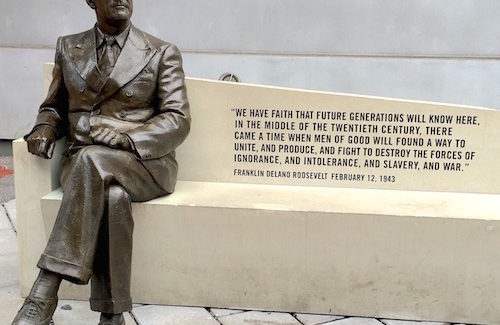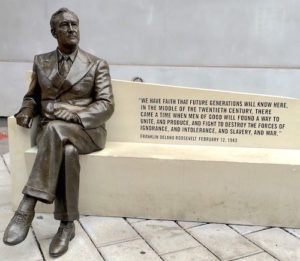Shore Excursion: New Orleans museum honors World War II heroes
By Jackie Sheckler Finch
When Navy corpsman Leo H. Sheer’s landing craft was sunk on its way to Omaha Beach on D-Day, the young sailor was forced to swim ashore amid heavy gunfire.
Arriving safely on the beach, Sheer began collecting first-aid pouches from the bodies of dead soldiers to help save the wounded. He hung six of the dead men’s pouches on his equipment belt.
Today, Sheer’s blood-stained web belt is displayed at the National World War II Museum in New Orleans. And it is artifacts such as this that help put a human face on the terrible war, said visitor Thomas Campbell of Omaha, Neb.
“When you see something like this belt, it brings home the struggle more than any book I’ve ever read about World War II,” Campbell said.
“My father served in World War II, but he would never talk about it. Now that he’s gone, I wanted to visit the museum to pay my respects to him and all the other veterans who paid such a high price for our freedom.”
Since its opening, the museum has quickly grown into one of New Orleans’ main attractions. Passengers arriving for riverboat cruises often make it a point to spend time in the popular museum.
Visiting the museum also answered a question for him, Campbell said. “I wondered why in the world this museum would be in New Orleans? You usually associate New Orleans with parties, good food and good times, not a serious museum like this.”
What he discovered, Campbell said, was that New Orleans was where more than 20,000 of the famed Higgins boats were made. The shoebox-shaped landing craft carried American troops ashore in the major amphibious assaults of World War II. Supreme Allied Commander Dwight D. Eisenhower once credited Higgins as “the man who won the war for us” because his shallow boat could land on almost any beach.
Noted World War II historian Stephen E. Ambrose, who founded the museum, also wanted the tribute located in New Orleans. Before his death in 2002 from lung cancer, Ambrose had lived about an hour from New Orleans. Ambrose spent decades researching and writing about World War II, Eisenhower and D-Day, including the books “Citizen Soldiers” and “Band of Brothers.”
As he collected more than 2,000 oral histories from D-Day veterans, Ambrose realized that the United States had no museum to honor these men and women and the people on the home front. The museum he founded presents the war from the viewpoint of regular soldiers, nurses, factory workers and folks at home.
‘The war that changed the world’
Formerly known as the D-Day Museum, the museum officially opened on June 6, 2000. Some 65 million people died in World War II, known as “the war that changed the world.”
D-Day on June 6, 1944, marked the invasion of Normandy, France, and the beginning of the end of the war in Europe. D-Day began shortly after midnight with the landing of 24,000 Allied airborne troops.
Amphibious landings began around 6:30 a.m. as about 156,000 servicemen from the United States, United Kingdom, Canada and other Allied countries disembarked from more than 5,000 ships and Higgins boats. They landed into a wall of gunfire from German defenders.
The operation cost U.S. forces 2,499 dead that day alone, with total Allied deaths reaching 4,414. By June 11, with beachheads firmly secured, more than 326,000 troops had crossed with more than 100,000 tons of military equipment. Paris was liberated on Aug. 25, 1944. Germany surrendered on May 8, 1945.
The museum’s two primary permanent exhibits focus on amphibious landings on Normandy and in the Pacific. Both feature photographs and newspaper articles, along with cases of weapons, helmets, uniforms and other historic object, as well as hundreds of individual stories. Touch screens along the walls offer two-minute video oral histories and cases containing letters, diaries and objects that belonged to individual soldiers.
Personal items on display
A simple metal “cricket” on display was carried by 22-year-old Private Ford McKenzie of the 101st Airborne on D-Day. Worn around his neck on a string, the cricket would make a clicking sound like the insect.
“One click of the cricket was supposed to be answered with two clicks,” McKenzie explained in the display. “If you didn’t click back, it was assumed you were the soon-to-be-dead enemy.”
Belonging to Arthur “Dutch” Schultz of the 82nd Airborne, a World War I brass knuckle knife was used by Schultz to cut himself out of his parachute on D-Day. Schultz also shared “a terrible memory” of that bloody June 6.
“I saw a paratrooper and I walked up to him. He was in a prone position. And I started talking to him,” Schultz said.
“He didn’t answer. I knelt down and I looked at him and realized, of course, he was dead. And what I saw was a bullet hole in the center of his forehead. It was the first dead man that I’d ever seen in my whole life.”
For Nicholas Bubrico, landing on Omaha Beach was a hellish nightmare. “We were on the landing craft and my buddy named Chester said, ‘I’m afraid. I can’t swim.’ I said, “Don’t worry about it. This boat will go right up to the land.’
But what happened was, when we came in, the sailors let the ramp down too quick, my buddy happened to be the first one out. As soon as we went out, a big wave caught the craft and pushed it over his body. A few days later, I heard from headquarters that Chester’s body was found on the beach. He was just a kid.”
A case honoring James Ogleby of Shreveport, La., contains the “deeply-regret-to-inform-you” telegram to his family, plus a statement from his brother that “everything changed” after Ogleby was killed. “Father started to drink and mother went to bed basically for two years.”
4-D high-tech movie
Opened in November 2009, the museum’s 250-seat Solomon Victory theater presents a moving spectacle billed as a 4-D experience that is far more than a film.
Narrated by actor Tom Hanks, “Beyond All Boundaries” is a multisensory presentation with smoke, simulated snow, shaking seats and other special effects. The high-tech flourishes are blended with graphic war footage and photographs to war to trace the war’s cause, its execution and its tragic toll.
A 1940s-era radio sits alone on the stage and begins at the real beginning — Dec. 7, 1941, “a day which will live in infamy.”
Voicing the words of American warriors and war correspondents are some of Hollywood’s most recognizable actors — Kevin Bacon, Patricia Clarkson, Viola Davis, Gary Sinise, Neil Patrick Harris, Tobey Maguire, Brad Pitt, John Goodman, Blythe Danner, Jennifer Garner, Justin Long, Elijah Wood and Wendell Pierce.
“People are visiting us because they want to understand what their mothers and fathers, grandfathers and grandmothers went through,” said Stephen Watson, chief operating officer for the museum. “It’s a way of honoring the generation that paid the price for our precious freedom.”
Photo by Jackie Sheckler Finch
















View Recent Comments